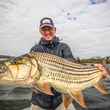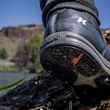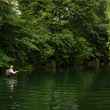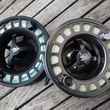John looked back and glared at me through his copper lenses. He was frustrated, exasperated and worn out. I’d just told John, for the third time, to drift his fly on the inside of a large midstream boulder. But his cast and the resulting drift were far away from the mark and even further away from any chance of hooking a trout. So I started to speak the sentence again, a little lighter this time, with a little more empathy.
“Just drift your fly on the inside of . . .”
John interrupted. He shook his head in anger and leaned in toward me.
“Man, if I could see the fly, I’d put it there.”
Only then did I understand. John simply didn’t know where his fly was.
Problems
Understanding the fly’s position — where it is and where it’s going — is the key challenge in fly fishing. And aside from basic casting skills, an awareness of the fly in the current is the most essential skill.
Arguably, the problem is most difficult when dead drifting nymphs. After the cast, where are the invisible flies under the water? But we can easily lose track of dry flies too, resulting in bad drifts, slow hook sets and lost fish.
Tracking dry flies with precision allows us to mend at the right times, to feed a little line and defeat a conflicting surface current. Likewise, we can guide a subsurface rig through the seams, around logs and down into deeper trenches only when we understand where the flies are.
Ultimately, good fly fishing is about good strike detection. And if we can’t track the flies, we can’t track the eats.
It comes down to hoping vs controlling the outcome. Without a solid awareness of your fly’s position, you’re just hoping to catch a fish. With it, you’re in control of the outcome. Fish on.
Solutions
Let’s start with the easy stuff. Often, you can improve the visibility of a dry fly by changing some materials. Choose white parachute posts or fluorescent dyed, visible wings. Use bleached deer hair for a Comparadun, or select crinkled, Hi-Vis material for spinner wings. Many of these material adjustments dramatically improve the visibility of a pattern, and most trout don’t mind.
Granted, there are trout in every river that will reject your well-placed dry fly for a host of reasons — and yes, maybe because they don’t like the color of your parachute post. When I find those fish, I often concede a victory and move on to the next riser. Invariably, I catch more trout with a dry fly I can see, simply because I fish it well.
If you must fish a small dry fly with dull colors and a flat form, then try pairing it with a second, more visible dry fly about 10-12 inches in front. The visible fly is a marker on the surface, and it will likely catch a few trout as well.
Lastly, brushing on a white desiccant like Frog’s Fanny can convert a no-see-um style of dry fly into something quite visible.
Imagine — It isn’t hard to do
Tracking dry flies on the surface is a cinch compared to the mental gymnastics required to visualize what’s going on with your flies under the water. But with the right tools and a little experience, it becomes intuitive.
I grew up drifting live minnows on small creeks in Pennsylvania. I remember casting up and across and guiding the unlucky fathead down through prime seams and pockets. I learned to stall the drift a little, allowing the minnow to teeter on its central axis and grasp its bearings just before I led it downstream again — that short stall, and a struggling minnow, drove trout crazy.
But I never really saw the minnow. Not once. I learned to visualize it and dance the bait downstream. And by ten-years-old the process was natural. I watched where the line entered the water, I judged my contact with the minnow by feel, and I read the mixed currents of those small, rocky streams. And with all of that information, I imagined where the minnow was. I imagined what it was doing.
Likewise, painting a mental picture — truly imagining your fly under the water — is the key trick to fishing nymphs, wets or streamers.
It starts with the cast. Watch for where the nymph or streamer enters the water. That’s the first reference point. And when you are accurate enough, when your casts go to where you send them, you can look for and find that small splash.
For now, let’s assume a tight line presentation, with no indicator. Once the fly enters the water, watch the line above the water and consider its angle. Incorporating a sighter in the leader helps tremendously.
Using a sighter (a highly visible section of monofilament built into the leader) provides the angler with tons of information about the drift. (I wonder how many more trout I could have caught on those minnows if I’d had a sighter as a ten-year-old kid.)
The sighter helps show contact with the rig. It tightens up a bit once you’re in touch with the weight underneath. If you’re in contact, then the sighter points to your fly. You can read (and control) the angle, speed and depth of the fly. With that information, it’s not much of a leap to imagine where the fly is among the underwater currents.
Under an indicator, it’s harder to know exactly where your nymph is, but it’s doable. And once again, it starts with a good cast.
Cast so the nymph lands directly upstream of the indicator, with very little slack. Watch for the small splash of the nymph. And then watch the indicator, the same as you watch the sighter. When the indy slows a bit, then it’s likely in touch with the weight underneath. And that’s what you want — the indy leading the nymphs downstream, usually slower than the surface current. Only then can you have a good idea where the nymph is. Only then can you accurately imagine the fly’s position — only when it’s in contact with the indy.
Again, good fly fishing is about good strike detection, and if the indy is not in touch with the weight underneath, then you’re back to hoping for a fish. If the indy is in touch, then you have a very good idea where your fly is drifting and much better control of the outcome.
Imagine the fly’s position.
Other stuff
Confidence in such imagination is built on experience, and a good way to quickly learn these things is by watching it happen. On the surface, the easy solution is to improve the visibility of the fly. Underneath, we can do something similar.
Take advantage of low and clear water conditions to learn what mixed currents really do to a nymph or streamer. Tie on a Green Weenie or another bright, visible nymph. Or use a white streamer, something you can really see. During the right water and light conditions, we can watch how the flies move. We can learn how our rod movements and line-hand strips affect the flies in relation to the currents. Stay close. Don’t worry about catching a fish. Instead, spend some time watching the Green Weenie and learning how to read the water in relation to the fly. Or watch the white streamer glide through the swing — and then make it stall for a second. Allow it to teeter on its central axis and grasp its bearings, just before you lead it downstream again.
With these experiences, you’ll learn to read the water in relation to the fly. And you’ll learn to truly imagine the fly’s position when you cannot see it.































Comments
Brian Mac Elroy replied on Permalink
Another great article Dom !!!
Anonymous replied on Permalink
You will have a hard time convincing me the color of your parachute post will stop a fish from taking your fly. The parachute post is above the water in the center of hackle. The fish aren't going to see it. The fish see the bottom of the fly. Unless your dry fly gets water log and you decide to fish it like a soft hackle to see if that might change your luck the color of your parachute post doesn't matter. When you tie a dry fly look at from the bottom. That's what the fish sees. If it looks like a bug from the bottom do whatever you want to the top. Go ahead and use a bright orange, pink, yellow parachute post. The fish won't care.
Bob Fornadley replied on Permalink
Great article, great advice and well written. Liked the observation about the line /sight
placed on the fly line. One thing though that is missing : the color of your line. I'll give my age away at this point and tell you that I've been fishing for 63 years and an avid fly fisherman for 57.
A white line or (ivory) has been my color of choice since I began.
Contrary to "studies" and line maker's opinions "white" or "ivory" stands out visibly in any shade of water, has never"spooked" any of the thousands and thousands of trout in my net in my lifetime nor any "dead drift" non-indicator impeded fished nymph or dry fly presented anywhere. You can follow it clear to your tippet and it makes following your fly a snap even for my old eyes. Ahh, I guess it's just not "sexy" enough and who listens to an old man with 57 years of solid experience, anyway ?? In the meantime I'll keep using my white lines and bet you all a cookie I can out-fish any of you who don't. This bet does NOT apply to anyone who does.... and I can follow any fly anywhere with the line pointing the way.
Pages